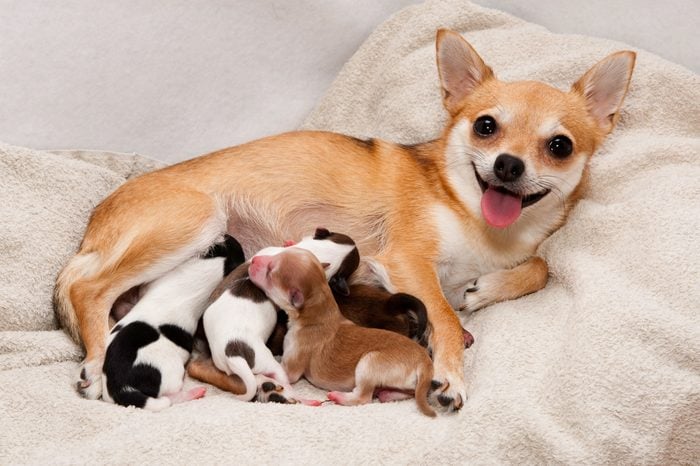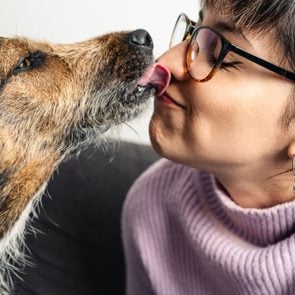How Long Are Dogs Pregnant? When to Expect Adorable Puppies
Updated: Mar. 25, 2024

Whether you have a pregnant dog at home or you’re just curious, here’s what you should know about how long it takes for a dog to have puppies … and just how many might be on the way
Are you excited about the arrival of some furry bundles of joy? Or maybe you’re worried because you’ve noticed a few changes in your dog’s behavior and your girl’s gotten a little wide in the middle. I’ve been a veterinarian for more than 25 years, and I’ve helped more pet parents than I can count navigate the sometimes turbulent waters of their dogs’ pregnancies. So you’re in the right place to get the answers to your dog-pregnancy questions, including: How long are dogs pregnant?
In my experience, knowing when puppies are due can make a big difference between enjoying the thrill of your dog giving birth or having it be an incredibly stressful time for everyone involved. Being prepared is vital, because it’s important for a dog’s labor to be monitored, and if problems pop up, you can call your veterinarian for advice. Even more dramatically, some dogs, like English bulldogs, should only give birth via C-section. These surgeries need to be scheduled during that small window of time when the puppies can survive outside the womb but the mom’s labor hasn’t started on its own.
Ahead, I’ll answer the question of how long it takes a dog to have puppies, as well as walk you through the stages of a dog’s pregnancy. Here’s everything you need to know.
Get Reader’s Digest’s Read Up newsletter for more pets, cleaning, humor, travel, tech and fun facts all week long.
| Reviewed for accuracy by: Amy Attas, VMD, an award-winning veterinarian, the founder of City Pets and the author of Pets and the City: True Tales of a Manhattan House Call Veterinarian. |
How long are dogs pregnant?
Dogs are usually pregnant for around nine weeks, and canine pregnancies follow a trimester pattern that’s similar to human pregnancies—but over the course of weeks instead of months. Of course, every dog (not to mention every pregnancy) is a little different, but big dogs generally have slightly longer pregnancies than small dogs.
The most accurate way to measure a dog pregnancy is in days, but you need to know when to start counting. Dog pregnancies can last anywhere from 57 to 72 days, with the average being around 63 days (or two months). For this kind of accuracy, you’d consider the first time a dog mates during her heat cycle as day one. If you know when your dog’s heat cycle ended, you can narrow things down even further: She will probably give birth 56 to 58 days later.
What are the signs that a dog is pregnant?
If you’re wondering whether your dog is pregnant, there are some telltale signs you can look for, both in their behavior and their bodies. That said, these early signs are very easy to miss, so you may not be aware that anything is going on until a few weeks before your dog gives birth. Talk to your veterinarian if there is any chance that your dog could be pregnant; they can also help you determine how far along she might be.
- 3 weeks pregnant: Poor appetite and possibly some vomiting are often the first signs that a dog is pregnant. This usually lasts for just a few days.
- 5–7 weeks pregnant: The dog’s nipples get larger and darker, and the hair around them may thin. Her belly will also get rounder (and may eventually hang lower to the ground).
- 8–9 weeks pregnant: The dog will engage in nesting behavior—either by digging or gathering blankets, pillows, clothes and paper in a quiet location.
- Early labor: The dog will start pacing and panting. Some dogs get clingier, but most want to be by themselves.
These signs can vary from dog to dog. For example, a large dog that is carrying only a few puppies probably won’t look too big, while the belly of a small, thin dog having a large litter can be enormous.
One caveat: All female dogs go through the hormonal changes associated with pregnancy after their heat cycle, even if they are not pregnant. This can make dogs look like they’re carrying puppies when they are not. And while the physical and behavioral changes can sometimes be mild, they can also be very convincing—with a non-pregnant dog sometimes even experiencing what appears to be labor! The best way to know whether your dog is pregnant is to schedule an appointment with a veterinarian, who can perform an ultrasound exam about four weeks after mating has occurred.
How long are dogs in labor?
The answer depends on how many puppies are going to be born and how fast the labor progresses. Starting from the very beginning of labor, anywhere between 12 hours and two days could be normal. Understanding the three stages of labor is key.
Stage 1
As labor begins, dogs will experience mild contractions, and the cervix will start to open to allow passage of the puppies. Dogs in stage 1 labor are often restless. They may pant, pace, tremble and work on their nest. Some dogs may vomit, and most have no interest in eating. You may also notice some clear, watery fluid emanating from your dog’s vulva. This stage of labor usually lasts between 12 and 24 hours.
Stage 2
Stage 2 labor is when the puppies arrive. You will see your dog actively pushing. Most of the time, one puppy will be born every 30 to 60 minutes. If more than two hours have passed between puppies, it’s time to call a veterinarian. Discharge may be clear, bloody or slightly green. Stage 1 signs often return between the arrival of puppies.
Stage 3
During stage 3, the dog will pass a placenta. Because each puppy has its own placenta, stage 2 and stage 3 labor should alternate. A puppy is born, followed by its placenta, and then another puppy and its placenta, and so on.
How many puppies can a dog have?

Normal litter sizes range from one to 12 puppies, although larger litters are certainly possible. Bigger and younger dogs tend to have larger litters than smaller and older dogs. It wouldn’t be unusual for a Chihuahua to have a litter of just one or two puppies, while the Guinness World Record holder is Tia, a Neapolitan Mastiff who had 24 puppies in a single litter in 2004.
It’s important to schedule X-rays seven or eight weeks into your dog’s pregnancy so your veterinarian can tell you exactly how many puppies to expect. This lets you know if your dog is done giving birth or if labor has stalled and you need to call your vet for help.
In how many months can a dog get pregnant again?
On average, dogs have a heat cycle every six months, so they can get pregnant about four months after giving birth. This means that dogs typically can get pregnant twice a year. However, a dog’s size plays a big role in this. Small dogs may go through a heat cycle three times a year (every four months), while large dogs and certain breeds like the Basenji often have only one heat cycle each year.
If you do the math, dogs can theoretically have 10 or more litters over their lifetime, but this is usually not in their best interest. After all, being pregnant and raising puppies through weaning is hard work: A dog’s need for energy (calories) goes up by 60% in late pregnancy and can increase by 200% to 400% when they are nursing a litter of puppies. Older dogs are also at a higher risk for having their own health problems, which could make pregnancy and delivery a riskier proposition. Good breeders often limit their dogs to three to five litters, after which the dogs can enjoy their retirement years.
What is the oldest age a female dog can have puppies?
Dogs do not go through menopause, so they can continue to have puppies well into their senior years. However, pregnancies tend to become more difficult and litters tend to be smaller after dogs are 5 to 7 years of age. This is a reasonable time to stop breeding. Except under special circumstances, the American Kennel Club will not register puppies that have been born to dogs who are more than 12 years old at the time of mating.
What is the youngest age a female dog can get pregnant?

Smaller dogs usually start having heat cycles when they are between 6 and 12 months of age, and it’s possible for these dogs to become pregnant as soon as that happens. Larger breeds, on the other hand, may not have their first heat until they are 12 to 18 months old and aren’t able to get pregnant until they do. If you don’t want your dog to become pregnant, it may be best to schedule a spaying appointment before their first heat. Talk to your veterinarian about the optimal timing for your dog.
Dogs should never have to deal with the demands of pregnancy and caring for a litter while they are still growing and developing themselves. They may simply not be able to take in enough nutrition to fuel their own bodies and also provide what their little ones need, leading to nutritional deficiencies for both. Breeders typically wait at least until a dog’s second heat cycle before they will allow her to become pregnant.
FAQs
Can you tell if your dog is pregnant at home?
You can order a dog pregnancy test online, but keep in mind that it is only accurate after a dog has been pregnant for four weeks. It also may not pick up very small litters. You can, however, look for signs that your dog might be pregnant, including her nipples becoming larger and darker and her belly getting bigger. However, as noted earlier, all female dogs can experience similar symptoms after their heat cycles, so this isn’t a reliable gauge of pregnancy.
Do dogs get pregnant every time they mate?
Healthy dogs typically become pregnant after mating. One study found that under certain circumstances, 95% of breedings were successful. The best way to know for sure if your dog is pregnant is to have your veterinarian perform an ultrasound exam about four weeks after the mating.
Do dogs know they’re pregnant?
It’s impossible to know if dogs understand the reason behind the changes they go through when they are pregnant. Are their behaviors instincts or evidence of a deeper understanding? We may never know enough to consider this a dog fact, but once the puppies are born, there’s no doubting the attachment that forms between the mom and her babies.
What does nesting look like in dogs?
Dogs that are nesting typically gather soft items like blankets, pillows, towels, clothing and paper products in an out-of-the-way location. Then, they will arrange (and rearrange) them to their liking. One word of warning: Dogs may rip up their bedding material to make everything just right for them, so make sure they have access to things you don’t mind throwing out after the nest is no longer needed.
Why trust us
At Reader’s Digest, we’re committed to producing high-quality content by writers with expertise and experience in their field in consultation with relevant, qualified experts. For this piece, Jennifer Coates, DVM, tapped her experience as a veterinarian with more than 25 years of experience, and then veterinarian Amy Attas, VMD, founder of City Pets and author of Pets and the City: True Tales of a Manhattan House Call Veterinarian, gave it a rigorous review to ensure that all information is accurate and offers the best possible advice to readers. We verify all facts and data, back them with credible sourcing and revisit them over time to ensure they remain accurate and up to date. Read more about our team, our contributors and our editorial policies.
Sources:
- Cornell Richard P. Riney Canine Health Center: “Dog estrous cycles”
- Theriogenology: “Semen evaluation and fertility assessment in a purebred dog breeding facility”
- Dvm360: “Optimizing pregnancy rates (Proceedings)”
- Merck Veterinary Manual: “Management of Reproduction: Dogs and Cats”
- Guinness World Records: “Largest Litter of Dogs”



